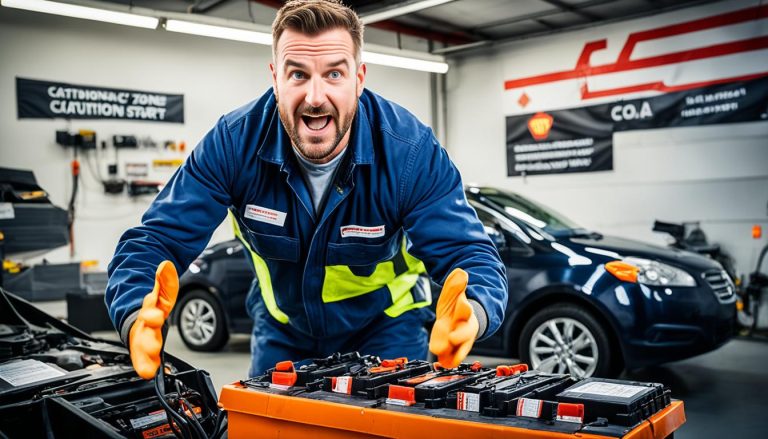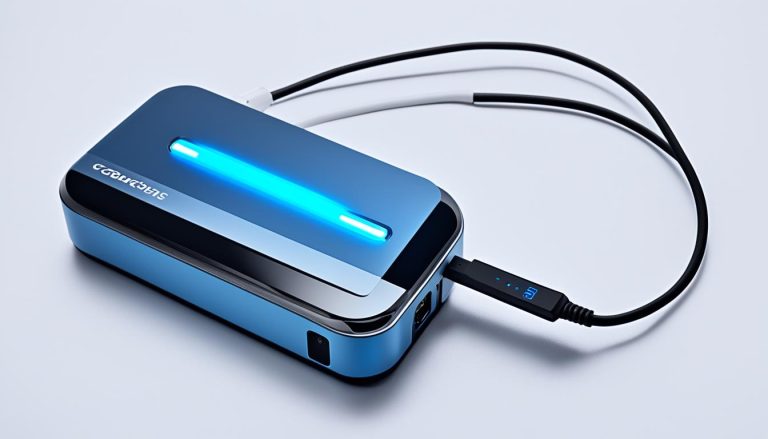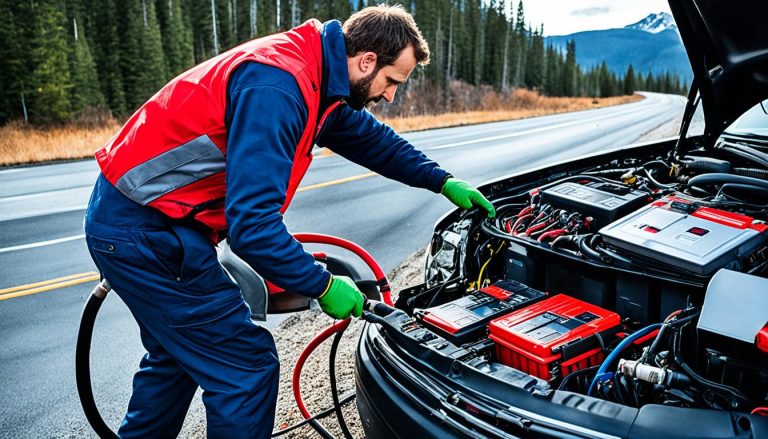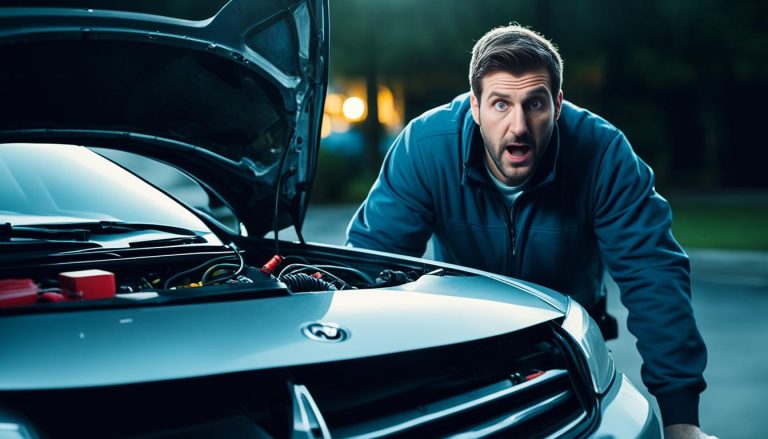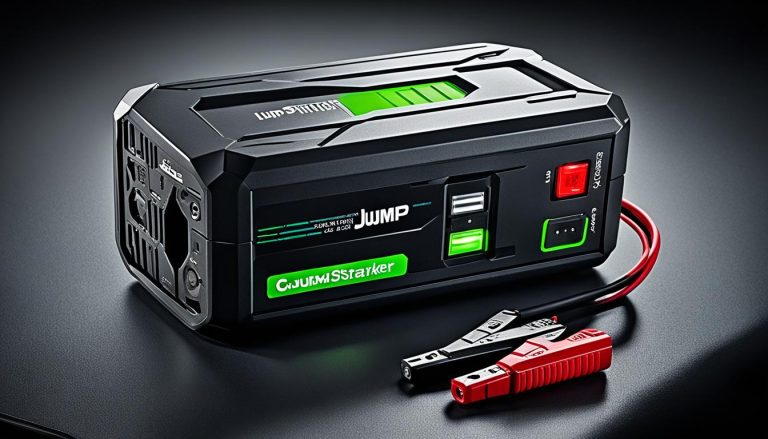Jump Start Car with Portable Battery Guide
batterychargers.site and its partners may earn a commission if you purchase a product through one of our links
Welcome to the reliable guide on how to jump start a car with a portable battery. If you’ve ever found yourself stranded with a dead car battery, you know how stressful it can be. Luckily, with the advent of portable jump starters, you’re no longer left to the mercy of waiting for another car to help you out. This handy portable jump starter guide will walk you through everything you need to know to safely get your vehicle running again.
Whether you’re dealing with an unexpected battery drain or just preparing for future road bumps, understanding how to jump start car with portable battery is an invaluable skill. You’ll soon be ready to handle a dead battery like a pro, keeping your travels smooth and interruption-free.
Key Takeaways
- Always adhere to safety recommendations, including using gloves and safety glasses.
- Ensure the portable jump starter is fully charged before attempting to use it.
- Connect the red clamp to the positive battery post and the black clamp to an unpainted metal surface.
- After successfully starting the car, drive it for at least 20 minutes to recharge the battery.
- Recharge your portable jump starter after use and maintain it for long-term reliability.
Understanding Portable Car Battery Jump Starters
When your vehicle’s battery dies, the solution doesn’t have to be a tow truck or a plea for help from strangers. With a portable car battery jump starter, you have the power to get back on the road quickly. These compact, powerful devices are a convenient solution to a common problem. Not all jump starters are created equal, however, and understanding the differences between models is key to selecting the best portable battery for jump starting your car.
The Basics of Portable Jump Starters
Portable jump starters are self-contained units capable of producing the necessary amperage to revive a dead car battery. Unlike traditional jumper cables that require another vehicle, these modern devices only need a charge to provide you with roadside assistance. Furthermore, they are designed with safety in mind to protect your car’s electronic systems.
Lead-Acid vs. Lithium-Ion Jump Starters
The debate between lead-acid versus lithium-ion in the realm of the best portable battery for jump starting a car is centered on weight, power, and lifespan. Lead-acid jump starters tend to be heavier and an economical option, making them suitable for individuals who are on a budget and don’t mind the extra weight. On the other hand, lithium-ion jump starters are valued for being lighter, having a longer shelf-life, and their ability to hold a charge more effectively over time.
Key Features of Modern Portable Boosters
As the demand for convenient, multi-functional tools grows, so does the array of features offered by portable jump starters. Many of the latest models go beyond mere jump starting; they serve as a power source for other electronic devices, come with built-in emergency lights, and even offer capabilities such as air compressors. The table below compares two popular models to showcase the variety of features they provide, demonstrating why they are considered an essential part of car emergency kits.
| Feature | Micro-Start XP-1-G2 | Equivalent Model A |
|---|---|---|
| Battery Type | Lithium-Ion | Lithium-Ion |
| Charging Ports | USB-C PD30w | USB-A 2.4A |
| Additional Functions | Radios, emergency lights, 12v outlets | Flashlight, 12v outlets, USB ports |
| Size & Weight | Compact & Lightweight | Compact & Lightweight |
| Price Range | Premium | Mid-range |
Whether you’re about to head out on a long road trip or just want to prepare for the unexpected, a portable car battery jump starter is a smart investment. By following easy steps to jump start your car with a portable battery, you can save time and manage battery-related emergencies with confidence.
Pre-Jump Start Safety and Preparation
Prioritizing safety is paramount when you’re about to jump start a car using a portable battery. Each step, from preparing equipment to putting on safety gear, is crucial for a successful and safe outcome. Let’s walk through the pre-jump start checklist to ensure that your experience with portable battery jump start guide is both effective and secure.
Reading Vehicle and Jump Starter Manuals
You wouldn’t dive into an unfamiliar recipe without reading the instructions first, right? Similarly, it is critical to read through both your vehicle and jump starter manuals thoroughly. These resources contain essential information, including whether your vehicle operates on a positive ground system, which is less common but necessitates a specific approach to jump starting a car with a portable battery. Understanding the manufacturer’s guidelines can mean the difference between a quick fix and a call for roadside assistance.
Ensuring Proper Charge Levels and Connections
A portable jump starter must be fully charged to be effective. Check for an indicator light or other sign that confirms the device is charged and ready to use. Also, ensuring a proper match between the voltage of your jump starter and the vehicle’s battery is just as vital as the charge level. Improper voltage can cause damage or render the jump start attempt ineffective.
Safety Gear and Precautions
Always suit up in safety gear like gloves and eye protection before attempting to jump start your vehicle. This protects you from potential sparks or battery acid. Furthermore, confirm that the area around the battery is clear of any flammable materials. It’s better to be over-prepared than to face preventable problems during a portable battery jump start.
When connecting the jump starter to your vehicle, the correct order must be followed: positive clamp to the positive battery terminal first, followed by the negative clamp to an unpainted metal surface on the car’s frame. And remember, the clamps should never touch each other once connected — a simple mistake that can have significant consequences.
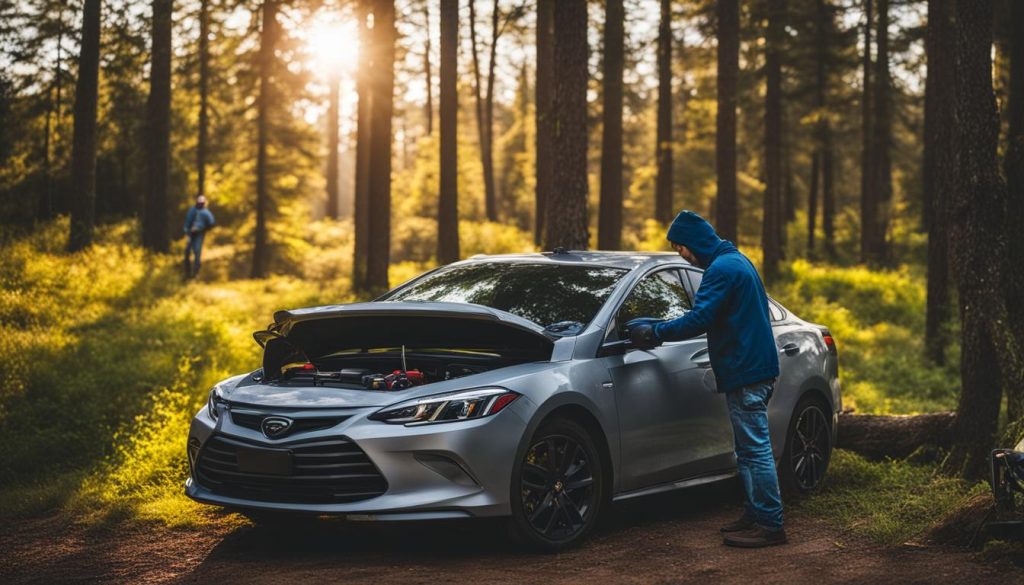
| Checklist Item | Details | Completion Status |
|---|---|---|
| Vehicle and Jump Starter Manuals Read | Understand steps for your car’s specificity | To be confirmed |
| Jump Starter Charge Level | Fully charged indicator status | To be confirmed |
| Voltage Match | Check that the starter and battery voltages align | To be confirmed |
| Safety Gear Equipped | Gloves and eye protection worn | To be confirmed |
| Proper Connection Order | Positive to positive, negative to ground | To be confirmed |
| Clamp Contact Prevention | Ensure clamps do not touch each other or incorrect surfaces | To be confirmed |
Once you’ve checked off each of these items, rest assured you’re ready for a secure jump starting process. You’re well on your way to mastering the portable battery jump start guide and being your own roadside hero.
Jump Start Car with Portable Battery: A Step-By-Step Guide
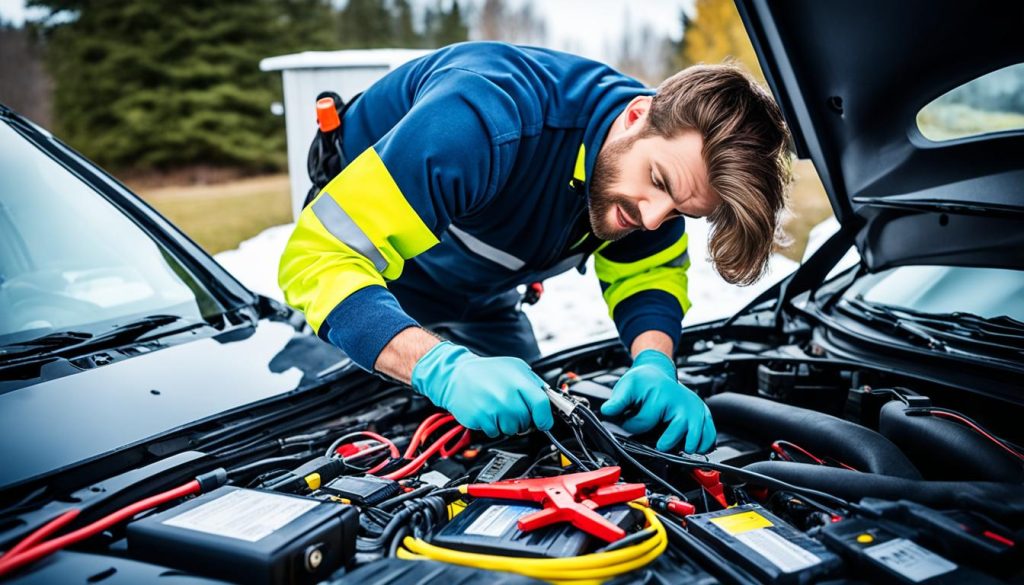
Being prepared to jump start your car with a portable battery can save you from the hassle of waiting for roadside assistance. Here’s a friendly step-by-step guide to get you back on the road swiftly.
Firstly, make sure that both your car and the portable jump starter are turned off. This safety precaution ensures that there are no unexpected sparks or electrical currents that could cause damage.
- Locate your car’s dead battery and identify the positive and negative terminals. The positive terminal is usually marked with a plus (+) sign and is often covered by a red cap.
- Attach the positive (red) clamp from the jump starter to the positive terminal of the battery.
- Find a clean, unpainted metal surface on your car’s frame or engine block to serve as a grounding point. Clasp the negative (black) clamp here, ensuring it’s away from the battery and any moving parts.
- Power on the portable jump starter. You should see an indicator light showing that the device is properly connected.
- Attempt to start your car. If it doesn’t turn over immediately, wait a few seconds before trying again. Patience is key here.
- Once the engine is running smoothly, switch the portable jump starter off before unclamping. Start by removing the negative clamp, followed by the positive clamp.
After jump starting, it’s crucial to let your car run for at least 20 minutes to allow the alternator to charge the battery. Meanwhile, safely store your portable jump starter, ensuring it’s ready for the next time you may need a jump start.
Always remember, jump start car with portable battery techniques are designed for convenience and your safety. Keep your portable battery charged, and you’ll always be prepared for those unexpected dead battery surprises.
Maintaining Your Portable Jump Starter for Optimal Performance
Meticulous upkeep of your portable jump starter not only extends its lifespan but ensures that it will be ready during those critical moments when you need it most. These essential tips for portable jump starter maintenance are crucial for everyone, from the daily commuter to the adventurous road tripper.
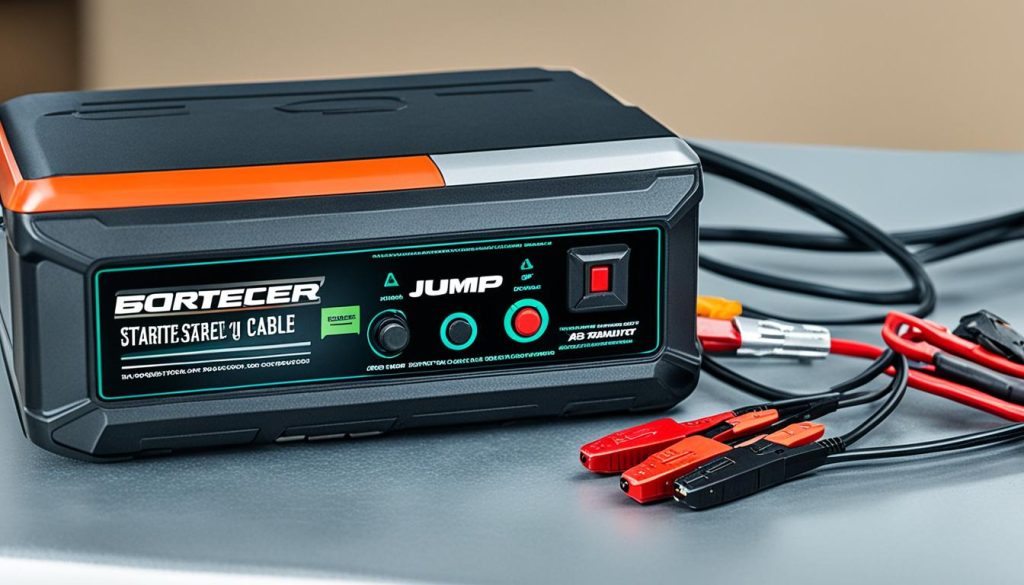
Regular Charging and Care Instructions
For optimal performance, a regular charging routine is paramount. After using your portable jump starter, charge it as soon as possible. If left unused, aim to recharge it at least every six months to prevent battery depletion which can lead to a shorter overall battery life. Portable car battery jump start tips also include periodic inspections of the battery status indicator, ensuring that the unit is holding a charge as expected.
Storage Best Practices
Where and how you store your portable jump starter can significantly affect its condition and functionality. Always store your device in a cool, dry place, away from direct sunlight and extreme temperatures which can damage the battery cells. For added protection, invest in a sturdy, protective case to shield your device from impacts and dust.
Inspecting and Replacing Cables and Clamps
It’s imperative to regularly inspect the cables and clamps for any signs of wear or damage. Frayed cables or corroded clamps can hamper the efficiency of your jump starter and might even become safety hazards. Should you find any issue, promptly replace them to maintain the reliability of your device.
| Maintenance Task | Frequency | Details |
|---|---|---|
| Charging the unit | After each use/Every 6 months | Prevents battery degradation and ensures readiness |
| Storage | Ongoing | Keep in a cool, dry place, inside a protective case |
| Inspection | Regularly/Before use | Check for damaged cables or clamps |
| Replacement | As needed | Replace any damaged parts immediately |
By following these maintenance guidelines, your portable jump starter will remain a dependable lifeline, ready to assist you whenever you encounter a battery-related hiccup on your travels.
Troubleshooting Tips for Portable Battery Jump Start Issues
Encountering issues with your portable jump starter can be a frustrating experience, especially when you’re faced with a dead battery. However, with some basic troubleshooting steps, you can determine the root cause and possibly find a simple solution to get back on the road. Let’s take a look at some common scenarios and how to resolve them.
When the Jump Starter Doesn’t Work
If you’re trying to jump-start your car and the portable battery jump starter isn’t working, first ensure it is fully charged. An indicator light typically shows charging status. Attach the clamps properly to the respective terminals, making sure they have a strong and secure connection. If issues persist despite a full charge and secure connections, it may be time to consult the manufacturer for support, as there could be an internal problem with your device.
Charging Failures and Battery Concerns
Should your portable jump starter fail to charge, check the power source and charging cable for functionality. Sometimes the issue may be as simple as using a faulty outlet or a damaged cord. If you’ve verified that the charger and outlet are working but the battery still won’t charge, it’s possible that the battery within the jump starter has reached the end of its lifespan and requires professional assessment or replacement.
Assessing Clamps and Connections
Effective troubleshooting of portable battery jump starters includes a thorough check of the clamps and connections. Ensure that clamps are not corroded, and the cables are not frayed or damaged, as this can prevent a successful jump start. Good maintenance involves regular inspection of these components to ensure they are always in optimal condition.

| Problem | Possible Cause | Solution |
|---|---|---|
| Jump Starter Not Charging | Dead outlet or faulty charging cable | Test another outlet or cable |
| Jump Starter Not Turning On | Internal battery issue or damaged power button | Contact manufacturer for support |
| Poor Connection with Battery | Corroded or improperly attached clamps | Clean clamps, attach properly, and retry |
Remember, when in doubt, it’s always best to consult the user manual that came with your portable battery jump starter or reach out to the manufacturer for troubleshooting support. These devices often have specific protocols for handling issues that can save you time and preserve the safety of your equipment.
The Role of Portable Battery Jump Starters in Modern Car Care
Imagine the inconvenience of a car that won’t start due to a dead battery. Now, consider the portable battery jump start importance in such a scenario. Gone are the days of relying solely on jumper cables and the benevolence of passersby. Modern drivers have adopted more effective car jump starting solutions to complement their automotive care essentials — none more crucial than the portable battery jump starter.
These compact lifesavers not merely serve as a remedy to dead batteries, but they are also an emblem of autonomy in the face of roadside challenges. They encapsulate a preventative measure as part of regular car maintenance—always ready to restore power to your vehicle’s battery, safeguarding your day’s plans against unexpected delays.
Your vehicle’s complex electronic system deserves a gentle touch, something portable battery jump starters are designed for. They supply a safe path for electricity, away from the tender circuits of modern cars, thereby preventing the potential harm that traditional jumper cables can inadvertently inflict.
| Feature | Benefit | Implication for Car Care |
|---|---|---|
| Portability | Use anywhere, anytime | Reduces dependency on others for jump start assistance |
| Safety | Prevents electronic system damage | Preserves car’s electronic integrity during jumps |
| Self-sufficiency | No need for a second vehicle | Instant assistance in any emergency |
| Modern Features | Includes USB ports, lights, etc. | Adds utility beyond jump starting |
Incorporating a portable jump starter in your vehicle maintenance protocol is not only prudent but equates to gearing up for the unexpected. It brings certainty to moments of unpredictability, standing as a testament to the importance of being equipped with effective car jump starting solutions.
Every driver who values peace of mind and readiness should consider a portable battery jump starter as crucial as the spare tire in their trunk.
Thus, as you navigate the ever-evolving landscape of automobile care, let the inclusion of a portable battery jump starter be a steadfast constant in your preparation routine. It’s a small but significant commitment to modern car care that yields immense return in convenience and safety.
Additional Features and Benefits of Carrying a Portable Jump Starter
While the primary function of a portable jump starter is to get your vehicle running when the battery falters, these compact powerhouses are equipped with a suite of extra functions enhancing their usability. Picture yourself in a scenario where your car battery decides to quit on you, but it’s not just the car that needs a boost. Your phone’s battery is low, and you’re expecting an important call. This is where the additional benefits of having a portable jump starter become immediately clear.
Built-In Device Charging and Power Banks
Today’s portable jump starters double as power banks, embodying the perfect blend of power and convenience. They often come with USB ports that make them capable of charging your smartphones, tablets, and laptops. A device that once lived in your trunk for rare emergencies now serves a daily purpose, keeping your electronic devices topped up when you’re on the move. This dual functionality ensures that your essential tech remains operational, giving these gadgets a prominent place in the suite of modern roadside essentials.
Emergency Lighting and Additional Utilities
Often underestimated and overlooked, the integrated emergency lighting feature in portable jump starters can be a beacon in the dark, quite literally. Whether you’re dealing with an unexpected issue at night or signaling for help in poor visibility conditions, the added utility of strong LED lights can be immensely helpful. In addition, some models boast other functionalities, such as air compressors for tire inflation — turning a simple battery booster into an all-in-one emergency toolkit.
The Convenience of Roadside Independence
Having a portable jump starter on hand does more than solve battery issues; it spells independence on the roads. Gone are the days of relying on the kindness of strangers or waiting for roadside assistance to arrive. With a portable jump starter in your vehicle, you have the capability to address not only dead batteries, but also other power-related needs, effectively enhancing your confidence and security whilst on your travels. These versatile devices ensure that you are well-prepared for a multitude of scenarios, making them indispensable companions for any road trip.
FAQ
How do you jump start a car with a portable battery?
To jump start a car with a portable battery, first make sure both the vehicle and the jump starter are turned off. Connect the red clamp to the positive terminal of the dead battery and the black clamp to an unpainted metal part on the car’s frame or engine block. Turn on the jump starter, then start your vehicle. Once the car starts, turn off the jump starter and remove the clamps in reverse order.
What are the different types of portable car battery jump starters?
The two main types of portable car battery jump starters are lead-acid and lithium-ion. Lead-acid jump starters are generally heavier and more affordable, while lithium-ion jump starters are lighter, more compact, and have a longer lifespan.
What should you do before attempting to jump start your vehicle?
Before jump starting your car, read both the vehicle and jump starter manuals to understand the proper procedures. Ensure the jump starter is fully charged, wear safety gear such as gloves and eye protection, and verify the voltage compatibility between your car battery and the jump starter. Make sure to set the parking brake for safety.
What safety precautions should you take when using a portable jump starter?
When using a portable jump starter, safety precautions to take include wearing safety glasses and gloves, ensuring the car and jump starter are turned off, and setting the parking brake. Make sure the clamps don’t touch each other or connect to the wrong parts of the vehicle, and stay clear from flammable substances.
What are the key features to look for in a modern portable jump starter?
Look for key features such as USB ports for device charging, emergency lights, radio functionalities, 12-volt outlets, air compressors, inverters, and new features like USB-C PD30w Charging to ensure versatility and utility beyond just jump starting your car.
How should you maintain your portable jump starter?
Maintain your portable jump starter by regularly charging it after use and every six months, inspecting cables and clamps for damage, keeping the unit clean, and storing it in a cool, dry place. Recharge it before long trips and store it in a protective case to prevent damage.
What should you do if your portable jump starter doesn’t work?
If your portable jump starter isn’t working, first make sure it is fully charged and the connections are correct and secure. Check the indicator light for charging status. If the issue persists, check for internal problems or contact the manufacturer for support.
Why are portable jump starters important for modern car care?
Portable jump starters are important for modern car care because they provide a safe and efficient way to jump start cars without the need for another vehicle, preventing potential damage to the car’s computer systems that could occur with traditional jumper cables. They’re especially useful for newer vehicles with multiple electronic systems
What additional features do some portable jump starters have?
Some portable jump starters come with additional features like built-in device charging and power bank functions, allowing for the charging of phones and laptops. They may also have emergency lighting, and some include air compressors for inflating tires, adding to their versatility for use in various situations.
How does having a portable jump starter contribute to roadside independence?
Having a portable jump starter contributes to roadside independence by removing the need to rely on the availability of another vehicle or tow services during a breakdown. It ensures that you can address a dead battery promptly and safely, providing peace of mind and convenience when on the road.

